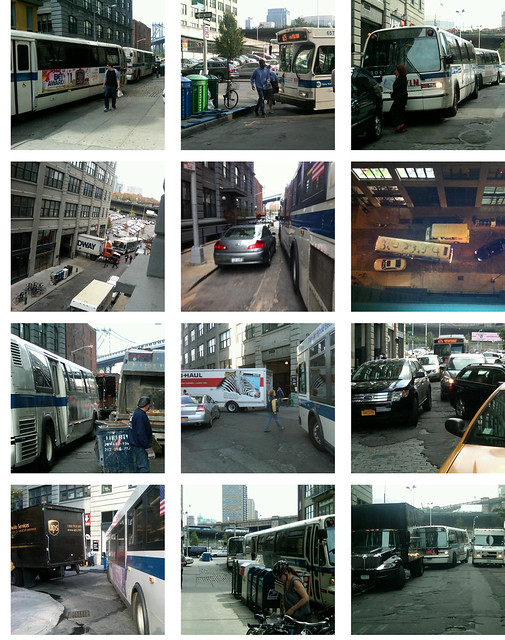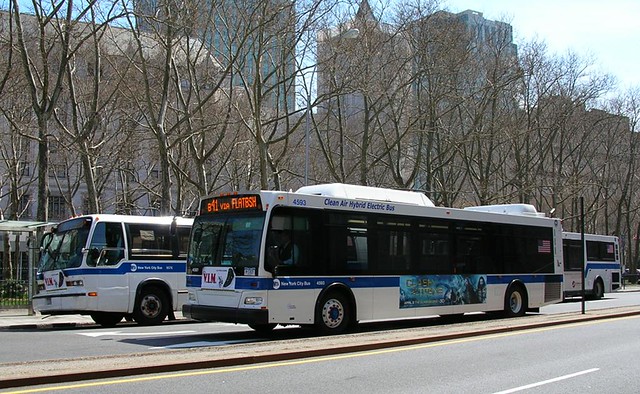
Photos from DUMBO seem to suggest that buses aren't creating traffic problems. (Photo by flickr user katebriquelet)
In his 1981 book The Highway and the City, Lewis Mumford wrote on the relationship between cars and urban life. “The right to have access to every building in the city by private motorcar in an age when everyone possesses such a vehicle is actually the right to destroy the city,” he said. Perhaps Mumford was overreaching a bit, but as we’ve seen over the last few years, New Yorkers go to crazy extremes to defend what they believe is their inalienable right to curbside access.
The most famous example of curbside NIMBYism came along 34th St. as residents decried the way a dedicated bus lane would — GASP — require them to walk from the corner or cross a street to get to their apartment buildings. They could not unload their cars! They could not get direct door-to-door taxi service! It was an urban NIMBY nightmare.
Recently, a similar situation long brewing in Brooklyn’s DUMBO neighborhood came to a head. Some local residents along Main St. have complained about the way the B25 ambles down Main St. as it turns around to head back toward Fulton St. on its way to East New York. Here’s how The Brooklyn Paper summed up the dispute:
Residents on Main Street in DUMBO are demanding that the Metropolitan Transportation Authority re-route a bus that they claim causes traffic jams and road rage on their already cramped street — saying it’s only a matter of time before someone gets run over by the B25. “We’ve been petitioning the MTA for years,” said Ethan Goldman, a vocal opponent of the B25 bus route. “This is a huge problem that could easily be fixed, but they refuse to listen.”
For decades, the B25 bus has run from Downtown to DUMBO via Cadman Plaza West before heading east on Front Street to Main Street.But that was before the neighborhood became a hotspot for families and art houses including Galapagos Art Space and powerHouse Arena.
Now during the morning rush, DUMBO residents complain that one or more buses get stuck between illegally parked delivery trucks and cars — creating a din of perpetual honking and screeching tires in a neighborhood that is already among the noisiest in the city.
Re-read that last paragraph and revel in its logic. The bus is a problem because it gets stuck behind illegally parked trucks and cars. It’s not the cars and trucks that are problematic; it’s the city bus. “If the enforcement is only way that this bus route is going to work, that’s a sign that this isn’t a good plan,” Rob Perris, district manager for Community Board 2, said.
The comments from DUMBO residents, gathered at the bottom of a post on Brownstoner and torn apart by Brooklyn Spoke are just as illuminating. Here’ s a gem:
Main Street is now a major destination in New York City, and on Saturday and Sunday there is asteady stream of limos coming down Main Street dropping off their parties on the street to takephotos in the park and to go to various restaurants in the neighborhood. The limos and the busesare engaged in a weekend-long battle for access to Main Street and wedding parties and guestsare regularly dodging the never-ending on-coming buses that always seem to travel in pairs.
In the same group of letters, inconsistencies abound. Some residents claim delivery fleets and illegally parked cars are a problem while others say the street is simply too narrow and too congested with children — who somehow navigate the delivery trucks and parked cars? — to support buses. The valid concerns of speeding bus drivers who aren’t respectful or careful enough of pedestrians are lost in the din of a group of people who just don’t like buses. (Although how the buses could be speeding that dangerously with the streets clogged with illegally parked cars is another conundrum here.)
DUMBO residents are seemingly alleging that buses are responsible for the traffic on their block, and their solution isn’t to enforce traffic laws or rethink the placement of loading areas. It is to ban buses. Let’s make it someone else’s problem so our idyllic little streets can be restored to their proper dignity, fit for cars and front-door deliveries. In any city, cars have a place; deliver vehicles have a place; limos and taxis have a place. But they do not have unfettered access to the streets at the expense of anything else. “Sharing” is a lesson we should have learned in kindergarten, but it is often lost on people battling over street space.
I believe Doug Gordon at Brooklyn Spoke summarizes it best: “New York is in a strange place right now. We have visionary leadership transforming our streets every day. We are home to some of the most innovative thinkers, business people, artists, and techies. But when it comes to thinking our way out of the traffic hell that engulfs so many neighborhoods–and the climate change that will come to swallow low-lying neighborhoods like DUMBO–it’s all too easy for the narrow-minded and loud to win out over the nuanced and creative.”








 (42nd Street Shuttle)
(42nd Street Shuttle)
 The New York State budgeting process is, by all accounts, a very, very messy one, and it’s even worse when the Senate is controlled by one party and the Assembly and Governorship controlled by the other. This year, with GOP lawmakers pushing for spending cuts and the MTA seeking money for its ongoing capital work, the debate over downstate dollars may turn sour. Yesterday, the New York State Senate, controlled by Republicans, voted to cut all capital subsidies for the MTA.
The New York State budgeting process is, by all accounts, a very, very messy one, and it’s even worse when the Senate is controlled by one party and the Assembly and Governorship controlled by the other. This year, with GOP lawmakers pushing for spending cuts and the MTA seeking money for its ongoing capital work, the debate over downstate dollars may turn sour. Yesterday, the New York State Senate, controlled by Republicans, voted to cut all capital subsidies for the MTA.